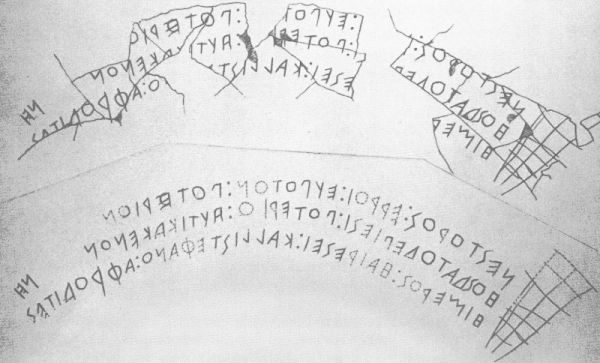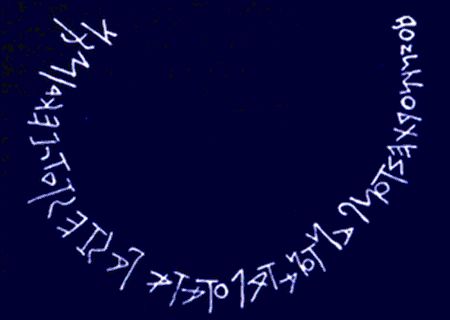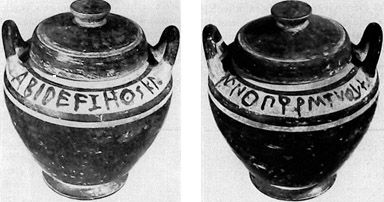Examples of writing
Alphabet table of Marsiliana d'Albegna (7th century)

Alphabetic line from the famous table of Marsiliana d'Albegna (Tuscany): a tablet with a raised edge, with its inner portion covered with a layer of wax which could be written on with a stylus; generally considered to be from the first half of 7th century BC. On the side shown here was engraved, from right to left, the oldest Etruscan alphabet known. This demonstrates the importation of the Greek alphabet by the Etruscans in an early age, and, consequently, the stabilization of the Greek alphabet (here Cumaen) before the 7th century.
Nestor's Cup (8th century)

Nestor’s Cup, a ceramic find coming from the Euboean colony of Pithikoussai (Ischia) and published for the first time in 1955, indicates at the same time both how common alphabetic writing was by the 8th century and the important permeation of the Homeric epic in Greek culture. The script reads from right to left. In the upper part of the image the part of the writing that has been conserved is shown, while the lower part of the image contains the reconstruction of the editio princeps (the text we give differs in the first line). Note the signs of aspiration, a rectangle cut in the middle, at the beginning of the second and third lines.
Νέστορός: [εἰμι]: εὔποτ[ον]: ποτέριο[ν]
hὸς δ᾽ἂν το̃δε π[ίεσι]: ποτερί[ο]: αὐτίκα κε̃νον
ἵμερ[ος αἱρέ]σει: καλλιστ[εφάν]ο: ᾽Αφροδίτης
I am Nestor’s cup, good to drink from.
Whoever drinks this cup empty, straightaway
desire for beautiful-crowned Aphrodite will seize.
Dipylon Oinochoe (8th century)

An oinochoe [wine jug] found in Athens in the Necropolis of Dipylon and roughly datable to 740 BC was the oldest form of Greek writing known to us until the discovery of Nestor’s cup. At the base of the neck it has an epigram in two verses engraved with a hard object. The first verse alludes to a sort of competition between dancers, while the second, probably incomplete, has not yet been interpreted: most probably it states that the oinochoe was the prize reserved to the most skilled dancer. It is worth noting the right-to-left script, the iota with three lines, the zeta in its oldest form (similar to an I), the symbol which developed as an heta, used to indicate aspiration (the first of the series from the right).
hὸς νῦν ὀρχηστῶν πάντων ἀταλότατα παίζει
τοτοδεκαλμιν
"The dancer who dances most delicately”
[text unclear]
Stamnos with alphabet strip from Metaponto (6th century)

Stamnos found near the ancient city of Metaponto, datable to the beginning of the 5th century BC, kept in the museum of Taranto. At its widest point an Achaen alphabetic series was traced before baking. Note how the “san” is used in place of the sigma (image on right) and the presence of the phi and chi in the third-to-last and second-to-last places; also note the koppa sign follows the pi.
Front: Α Β Γ Δ Ε Ζ F Η Θ Ι Κ Λ
Back: Μ Ν Ο Π (koppa) Ρ Σ Τ Υ Φ Ψ Χ
Exekias' signature (6th century)

Signature of the famous painter of the vase of Geryon, now at the Louvre, and datable to the middle of the 6th century BC. Light blue Attic alphabet: the ks sound is rendered through the combination of the chi (perpendicular to the imaginary line of writing) and the sigma (with three lines, as is usual in the Athenian epigraphic script until mid-5th century BC).
᾽Εχσεκίας ἐποίεσε
"Exekias made me"